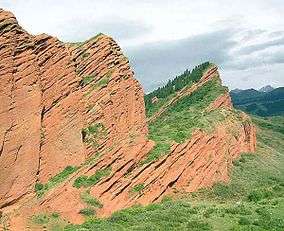Jeti-Ögüz Rocks
| Jeti-Ögüz Rocks | |
|---|---|
|
IUCN category III (natural monument or feature) | |
|
Seven Bulls rock formation near Jeti Oguz | |
| Location | Jeti-Oguz District, Issyk-Kul Province, Kyrgyzstan |
| Nearest city | Karakol |
| Established | 1975 |
The Jeti-Ögüz Rocks is a geological protected area (nature monument) located in Jeti-Oguz District of Issyk-Kul Province of Kyrgyzstan. It was established in 1975 with a purpose of conservation of a unique geological formation - sheer cliffs composed of tertiary red conglomerates.[1] The name derives from the rock formation's resemblance to seven bulls and a legend about a khan's unfaithful wife. Another near-by formation is called the 'broken heart'. The rock formation is a well-known landmark in Kyrgyzstan and is seen as a national or regional symbol, and hence is the subject of paintings, songs, and even music videos. The surrounding area is known for its natural beauty.
“About 25 km west of Karakol, at the mouth of the Jeti-Öghüz canyon is an extraordinary formation of red sandstone cliffs that has become a kind of tourism trademark for Lake Issyk-Kul.A village of the same name is just off the main around-the-lake road. Beyond it the earth erupts in red patches, and soon there appears a great splintered hill called Razbitoye Serdtse or Broken Heart. (Legend says two suitors spilled their blood in a fight for a beautiful woman; both died, and this rock is her broken heart.)
Beyond this on the west side of the road is the massive wall of Jeti-Öghüz. The name means Seven Bulls, and of course there is a story here too – of seven calves growing big and strong in the valley’s rich pastures. Erosion has meant that the bulls have multiplied. They are best viewed from a ridge to the east above the road. From that same ridge you can look east into Ushchelie Drakanov, the Valley of Dragons.”[2]
